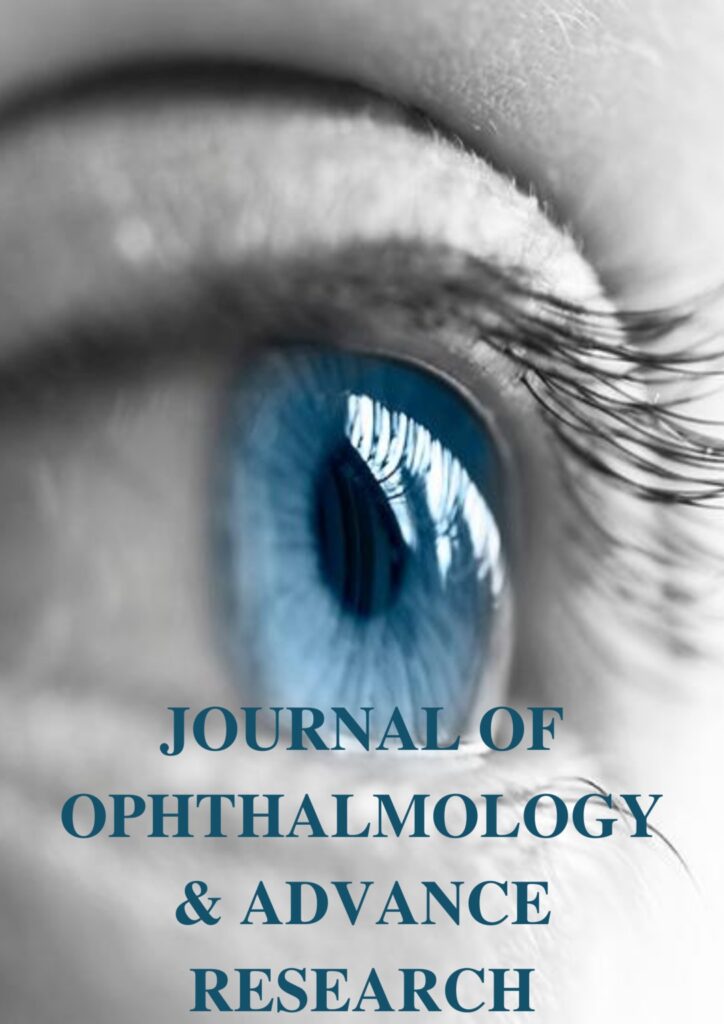Research Article | Vol. 6, Issue 1 | Journal of Ophthalmology and Advance Research | Open Access |
Disability-Adjusted Life Years Resulting From Ocular Injury-Traumatic Cataract Amongst Indian Population
Mehul A Shah1, Shreya M Shah1*, Riddhi Shah1, Nikita Balani1, Vedant Rajoria1, Raj Vador1
1Drashti Netralaya, Dahod, Gujarat, India
*Correspondence author: Shreya Shah, Drashti Netralaya, Dahod, Gujarat, India; Email: [email protected]
Citation: Shah MA, et al. Disability-Adjusted Life Years Resulting From Ocular Injury-Traumatic Cataract Amongst Indian Population. J Ophthalmol Adv Res. 2025;6(1):1-7.
Copyright© 2025 by Shah MA, et al. All rights reserved. This is an open access article distributed under the terms of the Creative Commons Attribution License, which permits unrestricted use, distribution, and reproduction in any medium, provided the original author and source are credited.
| Received 14 March, 2025 | Accepted 07 April, 2025 | Published 15 April, 2025 |
Abstract
Introduction: Ocular trauma poses a serious threat to vision, leading to visual impairment that significantly impacts quality of life and productivity. In this study, we calculate the Disability Adjusted Life Years (DALYs) for individuals affected by traumatic cataracts and assess the associated economic loss per DALY.
Method: This retrospective study analyzes traumatic cataracts following ocular trauma in all cases presented and managed at a single center. Demographic and clinical data were exported from an Electronic Medical Record (EMR) system into an excel sheet and analysed using SPSS22. We assessed the extent of vision impairment among cases and calculated DALYs using national and global data. Additionally, we estimated economic loss per DALY using standard formulas.
Results: Our cohort consisted of 2,093 eyes, with 70.3% males and 29.6% females and a median age of 25 years. Among these, 825 (39.4%) were from the pediatric age group (0-18 years). A significant portion of the cohort, 1,780 patients (85%), came from a poor socioeconomic background. We found that 57% of patients experienced vision impairment. Using these clinical data along with national and global data, we calculated the DALYs for traumatic cataracts to be 6,223, with the cost per DALY estimated at 6,426.2 USD.
Conclusion: Visual impairment resulting from ocular trauma contributes significantly to DALYs in India, imposing a substantial economic burden on both the country and society.
Keywords: Ocular Trauma; DALY; Traumatic Cataract; Economic Burden; Visual Impairment
Introduction
The proposed study focuses on the severe consequences of ocular trauma, which can lead to visual impairment and significantly impact the quality of life [1-5]. It aims to calculate Disability Adjusted Life Years (DALYs) to quantify the economic burden that ocular trauma imposes on society and the government, particularly in India. Trauma, especially in rural areas, remains an under-recognized health problem. Ocular trauma is a leading cause of monocular blindness, with its causes varying between rural and urban populations. The study highlights the importance of prevention to alleviate human suffering from vision loss and to mitigate societal costs arising from lost productivity and increased healthcare expenses [6-9].
By investigating the specific causes of ocular trauma in rural areas, the study seeks to offer valuable insights into preventive measures. Understanding the aetiology of these injuries will allow policymakers to better allocate resources for prevention, ultimately reducing the incidence of ocular trauma and its economic consequences. Ocular trauma presents a unique challenge because the visual outcome is often unpredictable. Multiple anatomical structures can be affected and no single factor determines the prognosis. While cataract management in cases of ocular trauma can lead to visual improvement, comorbidities like retinal detachment, corneal scarring and glaucoma often limit full visual recovery. This makes it difficult to establish uniform standards for classification, investigation and treatment.
Although the Birmingham Eye Trauma Terminology System (BETTS) provides some standardization in documenting ocular trauma, it remains insufficient for clinical prediction or uniform treatment. The presence of comorbidities plays a critical role in determining visual outcomes and impacts the individual’s quality of life. Traumatic cataracts are particularly challenging, as trauma usually affects not only the lens but also other vital ocular structures. As a result, while cataract surgery may restore partial vision, the overall success rate in cases of traumatic cataracts is lower than in senile cataracts. This is due to trauma-induced damage that compromises the potential for complete visual recovery.
Although the surgical techniques are similar for senile and traumatic cataracts, the success rate in traumatic cataracts is lower due to additional damage to ocular tissues, which limits the potential for full visual recovery. By documenting and comparing these outcomes, the study will underscore the challenges specific to traumatic cataract management and identify factors that limit success rates.
Additionally, the study aims to estimate the DALYs lost due to ocular trauma and traumatic cataracts. DALYs combine the years of life lost due to premature mortality with the years lived with disability, providing a comprehensive measure of disease burden. By calculating DALYs specific to ocular trauma in India, the study will offer insight into the broader economic impact of such injuries on the country’s healthcare system and productivity. This baseline data can facilitate global comparisons of the economic burden of ocular trauma.
The findings from this study will have significant policy and healthcare management implications. By calculating DALYs and estimating the economic costs of ocular trauma, the study will help guide resource allocation and inform prevention strategies. The data can be used to advocate for targeted preventive interventions, especially in high-risk populations and justify investments in trauma care and rehabilitation. This could lead to substantial cost savings for the healthcare system and improve the quality of life for affected individuals. Furthermore, the findings could serve as a model for other countries to estimate the economic burden of ocular trauma and develop their own prevention and management strategies. Ultimately, the study’s insights could contribute to reducing the economic and social burden of ocular trauma both in India and globally.
The findings from this study will have significant policy and healthcare management implications. By calculating DALYs and estimating the economic costs of ocular trauma, the study will help guide resource allocation and inform prevention strategies. The data can be used to advocate for targeted preventive interventions, especially in high-risk populations and justify investments in trauma care and rehabilitation. This could lead to substantial cost savings for the healthcare system and improve the quality of life for affected individuals. Furthermore, the findings could serve as a model for other countries to estimate the economic burden of ocular trauma and develop their own prevention and management strategies. Ultimately, the study’s insights could contribute to reducing the economic and social burden of ocular trauma both in India and globally.
For each patient enrolled, a comprehensive history was taken, detailing the injury, previous eye treatments and surgeries performed to manage past ocular trauma. Data was collected for both the initial and follow-up reports using the online BETTS (Birmingham Eye Trauma Terminology System) format from the International Society of Ocular Trauma. The details of each surgery were recorded using a pre-tested online form.
The traumatic cataracts were categorized into two groups: open-globe and closed-globe injuries. Open-globe injuries were further classified into those involving lacerations or ruptures. Lacerations were subdivided into perforating injuries, penetrating injuries or those involving an intraocular foreign body. Closed-globe injuries were subdivided into lamellar laceration and contusion.
For cases where the lens was partially opaque, posterior segment examination was carried out using an indirect ophthalmoscope with a +20 D lens. In cases where the optical medium was unclear, a B-scan was performed to evaluate the posterior segment. Other demographic details were also recorded, including patient residency, activity at the time of injury, object causing the injury and previous examinations and treatments.
After enrollment, all patients underwent a standard examination. Visual acuity was checked using Snellen’s chart and the anterior segment was examined using a slit lamp. Cataract surgeries were performed based on the degree of lenticular opacity. Postoperative follow-up was conducted according to clinical findings and Best Corrected Visual Acuity (BCVA) was assessed six weeks post-surgery. The visual outcomes were categorized and reasons for non-improvement in vision were documented.
Clinical data from this study regarding traumatic cataract visual outcomes and vision impairment were used to assess the burden of disease. Economic and general data were obtained from global and Indian government indices. The study population was classified into groups with mild, moderate and severe vision impairment following traumatic cataract management.
To estimate the burden of disease, Disability-Adjusted Life Years (DALYs) were calculated using the following formula:
DALY=Years Lived with Disability (YLD)+Years of Life Lost (YLL)\text{DALY} = \text{Years Lived with Disability (YLD)} + \text{Years of Life Lost (YLL)}DALY=Years Lived with Disability (YLD)+Years of Life Lost (YLL) [13-19].
Economic calculations of the cost averted per DALY were based on the formula:
0.01×Health Expenditure per capita/HDI×ASR DALY per capita0.01 \times \text{Health Expenditure per capita} / \text{HDI} \times \text{ASR DALY per capita}0.01×Health Expenditure per capita/HDI×ASR DALY per capita [8].
This formula was used to estimate the economic cost averted per DALY, considering health expenditure, Human Development Index (HDI) and Age-Standardized Rate (ASR) of DALY per capita. This study integrates both clinical and economic perspectives to evaluate the health and economic burden of traumatic cataracts in India over two decades [8,14].
Results
Our cohort consisted of 2,093 eyes, with 1,473 (70.3%) from male patients and 620 (29.6%) from female patients, with a median age of 25 years. Out of these, 825 (39.4%) were from the paediatric age group (0-18 years) (Table 1).
We examined the interval between the injury event and the presentation to the hospital, finding a median presentation time of 15 days. Among the total 2,093 cases, 5.2% had received prior treatment and 1.5% had undergone previous surgery.
A significant proportion of our cohort, 1,780 patients (85%), were from the poor socioeconomic group. Regarding the mode of hospital presentation, 1,442 patients (68.9%) self-reported, while 462 (22.1%) waited for a mobile diagnostic camp to reach the hospital. Additionally, 1,913 patients (91.4%) were from rural areas.
Following complete management 57% Patient had some form of impairment of vision (Table 2).
Socioeconomic status, habitat and age group appeared to influence the time interval between injury and hospital presentation.
Calculation of DALY for Traumatic Cataracts
- Years Lost due to Disability (YLD)
The formula for YLD is:
YLD=I×DW×L
Where:
- I = Incidence of the disease or condition=1134
1234567 total trauma cases out so incidence per 100000=1134 and average 60% having traumatic cataracts so incidence=680
- DW = Disability weight (how severe the disability is)=0.195
- L = Duration of the disease until remission or death=37.7
YLD=680×0.195×37.7=5001
2. Years of Life Lost (YLL)
The formula for YLL is: YLL=N×L
Where:N = Number of age-specific deaths per year
- L = Life expectancy at the age of death
The given information provides a life expectancy at age 28.5 based on Farr’s Death Rate Method using formula Qx = Mx / (Bx + (Mx/2) where
- Mx=560,000 (number of deaths at age 28.5)
- Bx=25,400,000 (total population at risk of death at this age)
YLL=560,000×0.0022=1232
3. Disability-Adjusted Life Years (DALYs)
Finally, DALYs are the sum of YLD and YLL:
DALY for Traumatic cataract =YLD+YLL=5001+1232=6233
Cost averted per DALY can be calculated by following formula.(ref)
Cost Averted per Daly= 0.01*Health Expenditure per capita/HDI*ASR DALY per capita
Cost= 0.01*58.38/0.644*84823=1.031 USD
Where:
- Per Capita Health Expenditure = 58.38 USD
- HDI (Human Development Index) = 0.644
- ASR DALY per capita = 84,823
Traumatic Cataract DALY=6233
Total Traumatic Cataract DALY averted cost for India is 1.031*6233=6426.2 USD
Sex | Total | ||
Female | Male | ||
0-10 | 133 | 284 | 417 |
Nov-20 | 138 | 364 | 502 |
21-30 | 90 | 257 | 347 |
31-40 | 94 | 188 | 282 |
41-50 | 67 | 162 | 229 |
51-60 | 50 | 140 | 190 |
61-70 | 40 | 63 | 103 |
71-80 | 8 | 15 | 23 |
Total | 620 | 1473 | 2093 |
Table 1: Age and sex distribution.
Vision Categories | No | Percent |
Mild impairment | 203 | 9.7 |
Moderate impairment | 271 | 12.9 |
Severe impairment | 173 | 8.3 |
Blindness | 530 | 25.3 |
>6/12 | 916 | 43.8 |
Total | 2093 | 100 |
Table 2: Visual impairment following management of traumatic cataracts.
Discussion
The current study involved 2,093 eyes, making it one of the largest databases of its kind. Of these, 1,473 (70.3%) were from male patients and 620 (29.6%) from female patients, with a median age of 25 years. Furthermore, 825 patients (39.4%) were in the pediatric age group (0-18 years). The study found that 57% of eyes had mild to severe visual impairment, which aligns with previous research. This visual impairment significantly affects quality of life [5].
A recent study estimated the cost of blindness in terms of Gross National Income (GNI) per capita, but only for individuals over 50 years old. Despite interventions in place for over two decades, Shamanna, et al., updated the information on the economic burden of blindness and visual impairment in India, showing a doubling in cumulative GNI loss due to avoidable blindness compared to 1997. This increase is driven by rising per capita income, economic productivity, a growing labor force, longer lifespans and a higher proportion of avoidable causes of blindness [20]. In 2017-18, government expenditure on healthcare in India was 1.33% of GDP and preventive care accounted for 6.8% (INR 364.8 billion or approximately Int$ 17.37 billion) of total expenditure. The net loss of GNI due to avoidable blindness in India is estimated at INR 689 billion (Int$ 31.3 billion), exceeding the expenditure on all preventable causes of blindness [8,19,20].
Health outcomes are closely tied to the Socio-Demographic Index (SDI), which combines economic, educational and fertility data to represent a country’s development. Disability-Adjusted Life Years (DALYs) are a valuable measure of disease burden for a population. For younger populations, such as those aged 10-24, where death or severe disability is rare, the impact of health issues is particularly significant due to the millions of healthy life years ahead of them. Despite efforts by the World Health Organization and VISION 2020, the global health burden of vision loss due to cataracts increased between 1990 and 2015 [20].
This study found that the DALY rate for total visual impairment in three pediatric age groups decreased significantly from 1990 to 2015, although the crude number of DALYs remained stable. Although several studies have explored cost-effectiveness thresholds globally, most have focused on high-income countries, using demand-side approaches. Little evidence exists on opportunity-cost-based thresholds in Low- and Middle-Income Countries (LMICs). This study, using global burden of disease data, estimated the cost per DALY averted for countries with different HDI levels and GDP per capita. The results aim to inform health policymakers about cost-effectiveness thresholds in these countries [8,19,20].
The current study assesses the burden of traumatic cataracts in India in 2022-23, using clinical data and age-standardized ocular trauma incidence. Nationwide, 1,234,567 ocular emergencies were reported, with 60% involving traumatic cataracts. Health expenditure and DALY trends in India during 2022-23 were analyzed to estimate the cost per DALY averted for visual impairment due to traumatic cataracts.
The analysis found a nonlinear negative relationship between per capita health expenditure (PPP) and Age-Standardized DALYs (ASR DALY), with the cost per DALY averted serving as a guideline for determining cost-effectiveness thresholds. In low HDI countries, the cost to avoid one DALY is approximately $1000 or about 0.34 of the GDP per capita. Interventions costing more than this threshold may not be cost-effective [8,21-23].
In comparison, Travor et al. studied the incidence of ocular injuries and their impact on DALYs in the U.S. military, finding that permanent injuries, though less frequent, accounted for most of the DALYs. While the incidence of superficial injuries, like corneal abrasions, was high, they contributed little to long-term disability. In contrast, more severe injuries like open globe injuries significantly increased DALY rates.
Interestingly, patients aged 19 to 24 had the highest DALY rates, consistent with the young age of service members. The sex distribution in Travor’s study was also similar to the U.S. military population, with 14.5% of eye injury patients being female, close to the 17.2% of females in the active-duty population. In the current study, 70.4% of patients involved in trauma were female [9].
The current study disagrees with the 2013 Global Burden of Disease (GBD) study, which assigned a low probability of permanent injury to eye trauma and used a disability score of 0.0165, leading to an estimated 0.007 DALYs per patient. This is much lower than the 0.64 DALYs per patient reported in the current study. The discrepancy arises because the GBD study calculated years lost to disability based on prevalence data rather than incidence, leading to lower DALY estimates. The lack of baseline data on traumatic cataracts in the GBD study also contributed to this difference [9].
Socioeconomic disparities have been identified as a major cause of inequality in eye health. Regions with higher GDP per capita and HDI have more ophthalmologists per million people, while low GDP and HDI regions struggle with limited access to eye care services. Education, a key component of HDI, also influences the annual use of eye services and affordability [8].
This study has several limitations. The single-center design may not reflect the heterogeneity of India, which has vast regional variations in health care access and outcomes. Additionally, data collection during emergencies was challenging and this study lacks disaggregated region-specific data. As Shamanna, et al., noted, the economic burden of blindness may vary significantly across different regions of India. Future studies should aim to provide region-specific, age- and gender-stratified prevalence data to more accurately assess the burden of blindness and visual impairment [20-24].
Conclusion
Visual impairment resulting from ocular trauma and traumatic cataract affect quality of life, which affect productivity and GNI of country more over it contributes significantly to DALYs in India, imposing a substantial and economic burden on both the country and society.
Conflict of Interest
The authors declare no potential conflicts of interest with respect to the research, authorship and/or publication of this article.
Funding Details
No funding was received for this review. No other financial disclosures of all authors.
References
- Khatry SK, Lewis AE, Schein OD, Thapa MD, Pradhan EK, Katz J. The epidemiology of ocular trauma in rural Nepal. Br J Ophthalmol. 2004;88:456‑60.
- Abraham DI, Vitale SI, West SI, Isseme I. Epidemiology of eye injuries in rural Tanzania. Ophthalmic Epidemiol. 1999;6:85‑94.
- Alfaro DV, Jablon EP, Rodriguez Fontal M, Villalba SJ, Morris RE, Grossman M, et al. Fishing‑related ocular trauma. Am J Ophthalmol. 2005;139:488‑92.
- Shah M, Shah S, Khandekar R. Ocular injuries and visual status before and after their management in the tribal areas of Western India: A historical cohort study. Graefes Arch Clin Exp Ophthalmol. 2008;246:191‑7.
- Shah M, Shah S, Chandana P. Impact of ocular trauma on vision-related quality of life. J Clin Ophthalmol Res. 2023;11:87-91.
- Anand S, Hanson, K. Disability adjusted life years: A critical perspective. J Health Economics. 1997;16:685-702
- Parks, R, The Rise, Critique and Persistence of the DALY in Global Health. J Global Health. 2014.
- Daroudi R, Akbari Sari A, Nahvijou A, Faramarzi A. Cost per DALY averted in low, middle-and high-income countries: evidence from the global burden of disease study to estimate the cost-effectiveness thresholds. Cost Effectiveness and Resource Allocation. 202119:1-9.
- Travor MD, Levine ES, Catomeris AJ, Purt B, Gensheimer WG, Justin G. et al. Disability-adjusted life years resulting from ocular injury among deployed service members, 2001-2020. Ophthalmol. 2024;131(5):534-44.
- Shah MA, Shah SM, Applewar A, Patel C, Patel K. Ocular Trauma Score as a predictor of final visual outcomes in traumatic cataract cases in pediatric patients. J Cataract and Refractive Surg. 2012;38(6):959-65.
- Shah M, Shah S, Shah S, Prasad V, Parikh A. Visual recovery and predictors of visual prognosis after managing traumatic cataracts in 555 patients. Indian J Ophthalmol. 2011;59(3): 217-22.
- He M, Wang W, Huang W. Variations and trends in health burden of visual impairment due to cataract: A global analysis. Invest Ophthalmol Vis Sci. 2017;58:4299-306.
- Salomon JA, Haagsma JA, Davis A. Disability weights for the Global Burden of Disease 2013 study. Lancet Glob Health. 2015;3(11):e712ee723.
- Kulothungan V, Ramamoorthy T, Sathishkumar K, Mohan R, Tomy N, Miller GJ, et al. Burden of female breast cancer in India: estimates of YLDs, YLLs and DALYs at national and subnational levels based on the national cancer registry programme. Breast Cancer Res Treat. 2024;205(2):323-32.
- Struijk EA, May AM, Beulens JW, de Wit GA, Boer JM, Onland-Moret NC, et al. Development of methodology for disability-adjusted life years (DALYs) calculation based on real-life data. PLoS One. 2013;8(9):e74294.
- Taylor HR, Jonas JB, Keeffe J. Disability weights for vision disorders in global burden of disease study. Lancet. 2013;381(9860):23.
- Li C, Fu Y, Liu S. The global incidence and disability of eye injury: An analysis from the global burden of disease study 2019. ClinicalMedicine. 2023;62:102134.
- Haagsma JA, Maertens de Noordhout C, Polinder S. Assessing disability weights based on the responses of 30,660 people from four European countries. Popul Health Metr. 2015;13:10.
- Nomura S, Yamamoto Y, Yoneoka D. How do Japanese rate the severity of different diseases and injuries? An assessment of disability weights for 231 health states by 37, 318 Japanese respondents. Popul Health Metr. 2021;19(1):21.
- Jelsma J, Chivaura VG, Mhundwa K. The global burden of disease disability weights. Lancet. 2000;355(9220):2079.
- Mannava S, Borah RR, Shamanna BR. Current estimates of the economic burden of blindness and visual impairment in India: A cost of illness study. Indian J Ophthalmol. 2022;70:2141-5.
- Vos T, Lim SS, Abbafati C, Abbas KM, Abbasi M, Abbasifard M, et al. Global burden of 369 diseases and injuries in 204 countries and territories, 1990–2019: a systematic analysis for the global burden of disease study 2019. The Lancet. 2020;396(10258):1204-22.
- GBD 2016 Risk Factors Collaborators. Global, regional and national Disability-Adjusted Life-Years (DALYs) for 333 diseases and injuries and Healthy Life Expectancy (HALE) for 195 countries and territories, 1990-2016: A systematic analysis for the Global Burden of Disease Study 2016. The Lancet. 2017;390(10100):1260-344.
- Abdolalizadeh P, Chaibakhsh S, Falavarjani KG. Global burden of paediatric vision impairment: A trend analysis from 1990 to 2017. Eye (Lond). 2021;35(8):2136-45.
Author Info
Mehul A Shah1, Shreya M Shah1*, Riddhi Shah1, Nikita Balani1, Vedant Rajoria1, Raj Vador1
1Drashti Netralaya, Dahod, Gujarat, India
*Correspondence author: Shreya Shah, Drashti Netralaya, Dahod, Gujarat, India; Email: [email protected]
Copyright
Mehul A Shah1, Shreya M Shah1*, Riddhi Shah1, Nikita Balani1, Vedant Rajoria1, Raj Vador1
1Drashti Netralaya, Dahod, Gujarat, India
*Correspondence author: Shreya Shah, Drashti Netralaya, Dahod, Gujarat, India; Email: [email protected]
Copyright© 2025 by Shah MA, et al. All rights reserved. This is an open access article distributed under the terms of the Creative Commons Attribution License, which permits unrestricted use, distribution, and reproduction in any medium, provided the original author and source are credited.
Citation
Citation: Shah MA, et al. Disability-Adjusted Life Years Resulting From Ocular Injury-Traumatic Cataract Amongst Indian Population. J Ophthalmol Adv Res. 2025;6(1):1-7.



